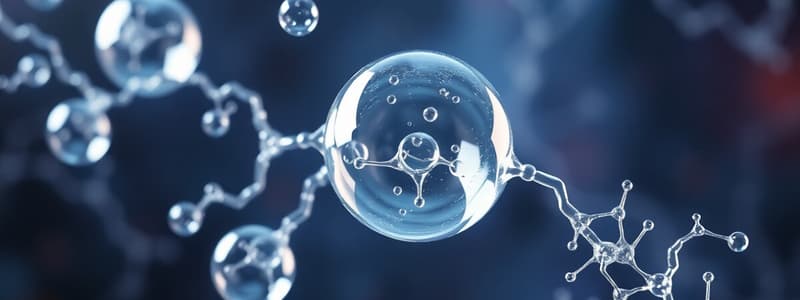Podcast
Questions and Answers
Which component of the Pyruvate Dehydrogenase Complex is responsible for the decarboxylation of pyruvate?
Which component of the Pyruvate Dehydrogenase Complex is responsible for the decarboxylation of pyruvate?
- Pyruvate dehydrogenase (E1) (correct)
- Dihydrolipoyl transacetylase (E2)
- Thiamine pyrophosphate
- Dihydrolipoyl dehydrogenase (E3)
What is the role of the lipoyl domain in the Pyruvate Dehydrogenase Complex?
What is the role of the lipoyl domain in the Pyruvate Dehydrogenase Complex?
- To produce NADH from NAD+
- To channel substrates between enzyme sites
- To covalently bind lipoic acid (correct)
- To decarboxylate pyruvate
How does substrate channeling benefit the function of the Pyruvate Dehydrogenase Complex?
How does substrate channeling benefit the function of the Pyruvate Dehydrogenase Complex?
- It minimizes side reactions. (correct)
- It reduces the need for coenzymes.
- It allows for more enzymatic steps.
- It increases the distance between catalytic sites.
Which of the following prosthetic groups is associated with Dihydrolipoyl dehydrogenase (E3) in the Pyruvate Dehydrogenase Complex?
Which of the following prosthetic groups is associated with Dihydrolipoyl dehydrogenase (E3) in the Pyruvate Dehydrogenase Complex?
What are the regulatory proteins associated with the Pyruvate Dehydrogenase Complex?
What are the regulatory proteins associated with the Pyruvate Dehydrogenase Complex?
What occurs during the oxidative decarboxylation of pyruvate?
What occurs during the oxidative decarboxylation of pyruvate?
Which vitamin is linked to the prosthetic group thiamine pyrophosphate in the Pyruvate Dehydrogenase Complex?
Which vitamin is linked to the prosthetic group thiamine pyrophosphate in the Pyruvate Dehydrogenase Complex?
What is one of the advantages of having short distances between the catalytic sites in the Pyruvate Dehydrogenase Complex?
What is one of the advantages of having short distances between the catalytic sites in the Pyruvate Dehydrogenase Complex?
What is the result of transferring an acetyl group to CoA in the process described?
What is the result of transferring an acetyl group to CoA in the process described?
Which product is formed during the reoxidation of the lipoamide cofactor?
Which product is formed during the reoxidation of the lipoamide cofactor?
How does the presence of long-chain fatty acids affect the regulation of PDH?
How does the presence of long-chain fatty acids affect the regulation of PDH?
What effect does a low ATP concentration have on the PDH complex?
What effect does a low ATP concentration have on the PDH complex?
What happens to pyruvate oxidation in the brain when thiamine is deficient?
What happens to pyruvate oxidation in the brain when thiamine is deficient?
What is the role of PDH kinase within the PDH complex?
What is the role of PDH kinase within the PDH complex?
Which metabolic condition is associated with mutations in the genes for PDH?
Which metabolic condition is associated with mutations in the genes for PDH?
What is the effect of overexpression of PDK1 in cells?
What is the effect of overexpression of PDK1 in cells?
What is the primary function of the mitochondrial pyruvate carrier (MPC)?
What is the primary function of the mitochondrial pyruvate carrier (MPC)?
Which cofactors are required by the pyruvate dehydrogenase complex during pyruvate conversion to acetyl-CoA?
Which cofactors are required by the pyruvate dehydrogenase complex during pyruvate conversion to acetyl-CoA?
What is the main energy output from the full oxidation of glucose during cellular respiration?
What is the main energy output from the full oxidation of glucose during cellular respiration?
Which stage of cellular respiration generates ATP and NADH?
Which stage of cellular respiration generates ATP and NADH?
How do mutations in MPC1 and MPC2 genes relate to cancer?
How do mutations in MPC1 and MPC2 genes relate to cancer?
What is the role of acetyl-CoA in the Krebs cycle?
What is the role of acetyl-CoA in the Krebs cycle?
What percentage of the total potential CO2 is released during Stage 1 of cellular respiration?
What percentage of the total potential CO2 is released during Stage 1 of cellular respiration?
What is the Pasteur point in relation to atmospheric oxygen concentration?
What is the Pasteur point in relation to atmospheric oxygen concentration?
Flashcards
Cellular Respiration
Cellular Respiration
A metabolic process in organisms utilizing oxygen to break down glucose and release energy. This process is used by microorganisms, plants and animals.
Pyruvate Oxidation
Pyruvate Oxidation
Converts pyruvate to Acetyl-CoA in the mitochondria. It is an oxidative decarboxylation of pyruvate.
Acetyl-CoA
Acetyl-CoA
An important molecule for generating ATP, NADH, FADH2. It's a crucial step in cellular respiration, linking glycolysis to the Krebs cycle.
Mitochondrial Pyruvate Carrier (MPC)
Mitochondrial Pyruvate Carrier (MPC)
Signup and view all the flashcards
Glycolysis
Glycolysis
Signup and view all the flashcards
Warburg effect
Warburg effect
Signup and view all the flashcards
Mitochondria
Mitochondria
Signup and view all the flashcards
Pasteur point
Pasteur point
Signup and view all the flashcards
Pyruvate Dehydrogenase Complex (PDC)
Pyruvate Dehydrogenase Complex (PDC)
Signup and view all the flashcards
Substrate Channeling
Substrate Channeling
Signup and view all the flashcards
Thiamine Pyrophosphate (TPP)
Thiamine Pyrophosphate (TPP)
Signup and view all the flashcards
Lipoamide
Lipoamide
Signup and view all the flashcards
Oxidative Decarboxylation
Oxidative Decarboxylation
Signup and view all the flashcards
Pyruvate Decarboxylation
Pyruvate Decarboxylation
Signup and view all the flashcards
Prosthetic Group
Prosthetic Group
Signup and view all the flashcards
PDH Complex Regulation
PDH Complex Regulation
Signup and view all the flashcards
PDH Inhibition
PDH Inhibition
Signup and view all the flashcards
PDH Activation
PDH Activation
Signup and view all the flashcards
PDH Phosphorylation
PDH Phosphorylation
Signup and view all the flashcards
PDH Dephosphorylation
PDH Dephosphorylation
Signup and view all the flashcards
PDH Mutations
PDH Mutations
Signup and view all the flashcards
Thiamine Deficiency
Thiamine Deficiency
Signup and view all the flashcards
Beriberi and Polished Rice
Beriberi and Polished Rice
Signup and view all the flashcards
Study Notes
Atmospheric Oxygen Changes Over Time
- Atmospheric oxygen levels have fluctuated significantly throughout Earth's history.
- The graph shows a gradual increase in atmospheric oxygen over billions of years.
- The Pasteur point, a threshold of 0.3% oxygen, is critical because it marks the beginning of oxidative phosphorylation.
- Prior to reaching the Pasteur point, energy production was anaerobic. Once the point was exceeded, aerobic metabolism became possible.
Pasteur Point
- Oxidative phosphorylation, a crucial process for energy production, only occurs at or above the Pasteur point.
- This point corresponds to an atmospheric oxygen concentration around 0.3%.
- Before this point, cells relied on anaerobic respiration for energy.
Glycolysis
- Glycolysis is an anaerobic process that partially oxidizes glucose.
- The process produces pyruvate.
- It captures a smaller amount of energy compared to full aerobic oxidation.
- The change in free energy, ΔG°, during glycolysis is -146 kJ/mol.
Full Oxidation of Glucose
- Full oxidation of glucose occurs in aerobic conditions.
- The oxidation process uses oxygen and produces significantly more energy.
- The change in free energy, ΔG°, during full oxidation of glucose is -2,840 kJ/mol.
Cellular Respiration
- Cellular respiration is a fundamental process in microorganisms, plants, and animals.
- The process encompasses three major stages:
- Acetyl CoA production.
- Acetyl CoA oxidation
- Electron transfer and oxidative phosphorylation
Catabolic Fates of Pyruvate
- Pyruvate is a key intermediate in cellular metabolism.
- In aerobic conditions, pyruvate is channeled to acetyl CoA production and further oxidation in the citric acid cycle.
- In anaerobic conditions, pyruvate is converted to lactate in certain cells and microorganisms.
- Fermentation to ethanol in yeast is another process that involves pyruvate under anaerobic conditions.
Pyruvate Oxidation in Mitochondria
- Mitochondria are responsible for pyruvate oxidation.
- The process involves the conversion of pyruvate to acetyl-CoA.
Mitochondrial Pyruvate Carrier (MPC)
- MPC is a transport protein facilitating pyruvate import into mitochondria, passing through the outer, then inner mitochondrial membranes.
- It is vital for aerobic respiration for carrying out the Krebs cycle.
- Acetylation of MPC leads to transport inhibition.
Entry of Pyruvate into Mitochondria
- Pyruvate diffuses through porins in the outer mitochondrial membrane.
- The inner mitochondrial membrane is impermeable to pyruvate; therefore, the MPC transports pyruvate to the matrix.
- MPC1 and MPC2 gene mutations are frequently found in cancers like gliomas.
- The mutation limits pyruvate oxidation limiting energy production. This has implications for the Warburg effect.
The Warburg Effect
- Some cancer cells prefer glycolysis even in the presence of oxygen.
- This is called the Warburg effect, where the rate of glucose uptake and conversion to lactate is unusually high in tumors.
- Tumors may have a high rate of Warburg effect causing high levels of lactate production.
Conversion of Pyruvate into Acetyl-CoA
- The process involves a complex of three enzymes.
- The complex requires five cofactors, including TPP, lipoate, and FAD.
- The reaction produces acetyl-CoA and CO2.
Pyruvate Dehydrogenase Complex (PDC)
- PDC is a large multienzyme complex.
- It catalyzes the oxidative decarboxylation of pyruvate to acetyl-CoA.
- The process involves three enzyme subunits (E1, E2, E3).
- Advantages of their organization include short distance between catalytic sites improving rate enhancement and substrate channeling preventing unneeded side reactions.
E. coli PDH Complex
- The E. coli PDH complex comprises three enzymes (E1, E2, and E3) and their associated prosthetic groups.
- It's larger than a ribosome.
- Regulatory proteins like protein kinase and phosphatase help control the complex's activity.
Structure of Lipoyllysine
- The lipoyl group is a prosthetic group for E2.
- It exists in three states: oxidized, reduced, and acetylated.
- The lipoic acid is covalently linked to a lysine residue in E2.
Overall Reaction of PDC
- Coenzyme TPP de-carboxylates pyruvate.
- The hydroxyethyl group on TPP is oxidized to an acetyl group.
- The acetyl group is transferred to CoA forming acetyl CoA (product one) and reducing FAD.
- The reduced lipoyllysine is oxidised resulting in reduced FAD which is oxidised by NAD, with the result of NADH.
Sequence: Oxidative Decarboxylation of Pyruvate
- The process of converting pyruvate to acetyl-CoA occurs through a five-step sequence.
- The steps are catalyzed by the three enzymes of PDC complex.
- CO2 is released, and the hydroxyethyl group is oxidized into an acetyl group. Acetyl-CoA is the overall product.
E3 Subunit of PDC
- The E3 subunit of PDC is structurally (and functionally) similar to a-ketoglutarate dehydrogenase.
Regulation of PDH
- The activity of pyruvate dehydrogenase is regulated through allosteric and covalent mechanisms.
- Product inhibition (by ATP, Acetyl-CoA and NADH) and long-chain fatty acids decrease PDH activity.
- It is activated by AMP, CoA, and NAD+.
Regulation of PDH (Phosphorylation)
- Reversible phosphorylation of serine on E1 regulates PDH activity.
- Phosphorylation inactivates E1, while dephosphorylation activates it.
- The kinase is active in the presence of high ATP, NADH, and acetyl-CoA. It's inhibited in the presence of low ATP, AMP, and CoA.
Mutations, Deficiency, Treatments
- Mutations in PDH genes can lead to lactate acidosis and weakness.
- Thiamine deficiency causes beriberi.
- Conditions like beriberi are often seen when diets are low in thiamine.
- Dichloroacetate (DCA) can be used as a treatment for PDH deficiency by blocking the enzyme that inactivates PDH.
Glucose Consumption and Lactate Production
- Aβ-resistant nerve cells exhibit increased glucose uptake and glycolytic activity, thus higher lactate production.
- This correlates with possible Alzheimer's disease.
Overexpression of PDK1
- Overexpression of PDK1 in B12 cells confers resistance to apoptotic stimuli like 20 μM Aβ, 200 μM H2O2, and 300 ng/ml Staurosporine.
Studying That Suits You
Use AI to generate personalized quizzes and flashcards to suit your learning preferences.




